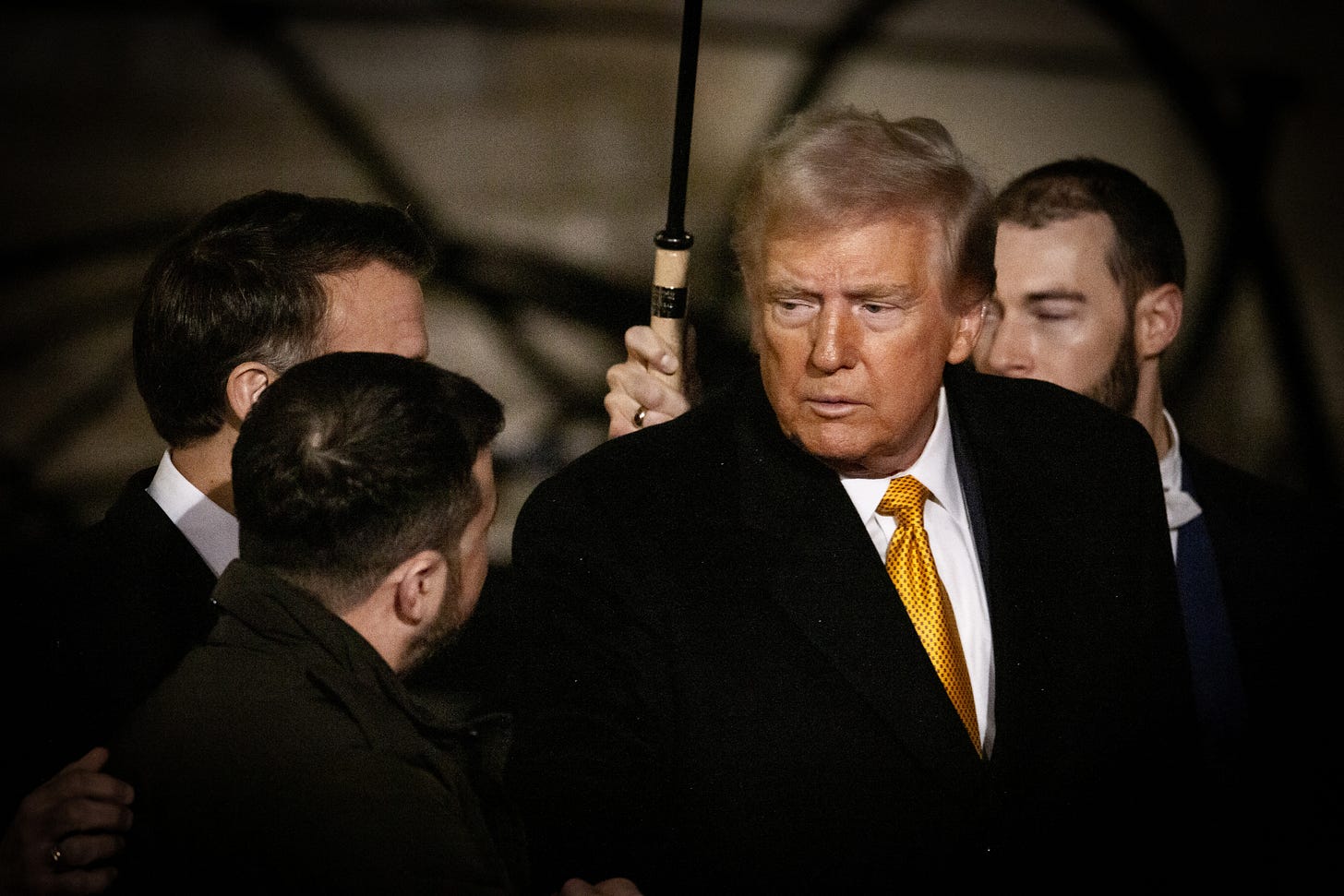
These Mothers Fought for Their Sons Killed by Police. Now They’re Fighting for the Country.
May 27, 2025
Another Indefensible Trump Pardon
May 27, 2025IS DONALD TRUMP GOING TO WALK AWAY from Ukraine? Who knows—only a fool would try to predict. His strategy, if we can call it that, changes from day to day, and his true motives, particularly with regard to Russia, are inscrutable. But all signs suggest that he may be about to give up on his oft-repeated promise to end the war.
As Trump finally recognized and admitted last week on a phone call with European leaders, Vladimir Putin isn’t ready to stop fighting. The Kremlin proved this and then some over the long weekend, hitting Ukrainian cities with nearly a thousand missiles and drones, among the worst attacks of the war. Arrogant and ill-informed, the Russian strongman thinks he’s winning.
The latest burst of Russian violence prompted Trump to criticize Putin: “He has gone absolutely CRAZY! He is needlessly killing a lot of people, and I’m not just talking about soldiers.” But the president also scolded Ukraine’s Volodymyr Zelensky: “Likewise, President Zelensky is doing his Country no favors by talking the way he does. Everything out of his mouth caused problems.” And nothing suggests that Trump is likely to re-engage with the peace process. With no deal in sight, the White House says it’s going to take a back seat as low-level Russian and Ukrainian diplomats launch pro forma talks at the Vatican.
Some Ukrainians will breathe a sigh of relief. Most are tired of fighting, eager to end the war and get on with rebuilding their battered country. But no peace is better than a bad settlement—and what Trump has been pushing for the last few months often struck Kyiv as deeply unfair and unsustainable.
Still, the sad truth is there is no other end game. The only realistic way to end the war is with Western pressure—the United States and Europe working together to compel Putin to stop. Ukrainians are determined to go on fighting if need be, with or without American help. As they see it, they have no choice—their existence as a nation is at stake. Yet something dramatic would have to change for either Kyiv or Moscow to prevail on the battlefield. So the two sides are gearing up, as they did last year and the year before that, for another long, bloody, inconclusive summer.
What isn’t so certain: what the United States will do next.
American public opinion is deeply divided. According to a recent survey of American adults by the Pew Research Center, 67 percent of Democrats think the United States has a responsibility to help Ukraine defend itself, compared to just 23 percent of Republicans. But a large bipartisan majority—69 percent, including 63 percent of Republicans and Republican leaners—believes the war is somewhat or very “important to U.S. national interests.” Nearly as many—56 percent, including 47 percent of Republicans and Republican leaners—say it’s important to them personally. And no Americans want to create another Afghanistan debacle by abandoning an ally to be overrun by hostile forces.
This doesn’t mean Americans are prepared to resume large-scale military assistance to Ukraine—there’s no sign of that. But there are still three ways we can help: weapons sales to Ukraine, stepped-up sanctions against Russia, and maintaining the flow of critical U.S. intelligence to Kyiv.
WEAPONS SALES SHOULD BE the easiest step for the transactional Trump administration. In an ideal world, the Congress and the administration would go on providing lethal aid, no strings attached, to a democratic ally defending itself against an expansionist authoritarian power. But few Ukrainians expect this, and Zelensky took a new tack in early April, offering to purchase up to $50 billion worth of U.S. weaponry. “We will find the money and pay for everything,” the Ukrainian leader emphasized.
At first, Trump blew off the offer, perhaps not understanding that Kyiv meant sales, not conventional aid. But by early May, the president seemed to grasp the difference, with the White House announcing it would allow American companies to sell at least $50 million worth of weaponry to Ukraine—direct commercial sales, not, as in the past, purchases by the Pentagon on Kyiv’s behalf.
Fifty million dollars won’t go very far—by comparison, over three years of war, the United States has provided $129 billion in military and other aid. But it’s an important first step, squarely in U.S. business interest.
Ukraine needs many things. Its military relies on American hardware and software for virtually every move it makes, tactical and strategic. But the way to start expanding weapons sales would be to take up Zelensky’s offer of $15 billion for ten Patriot air-defense missile systems. It’s a fair price—Patriots cost about $1.1 billion each—and Kyiv desperately needs them. No other weapon system can shoot down the deadly ballistic missiles that Moscow sends every few days to destroy Ukrainian cities.
STEP TWO, TOUGHER SANCTIONS, may be a more difficult ask. A remarkable 78 senators, Democrats and Republicans, have cosponsored a bill, crafted by Republicans Lindsey Graham and Tom Cotton with Democrat Richard Blumenthal, to defang the Russian war machine with tough sanctions on countries like China and India still trading with Moscow. Trump has repeatedly said—most recently on Sunday—he would consider tightening the economic screws on Moscow.
But no matter how brazenly Putin thumbs his nose at the peace process, Trump never makes good on his threats—he has done nothing yet to punish or pressure the Kremlin. Rubio’s explanation: “If we start threatening sanctions, the Russians will stop talking. There’s value in us being able to talk to them and drive them to get to the table.” Still, as the world learned this spring during Trump’s tariff rollout, the president can be persuaded, backing off even his most cherished beliefs if the pressure is strong enough.
The Graham bill takes just the right approach. The sanctions imposed over the past three years cover a wide range of economic activity—curtailing trade, capping the price of Russian oil, and limiting Russian access to the international financial system. Together, these constraints have inflicted painful damage. But Moscow has found ways around some of them, including by using an uninsured “shadow fleet” of tankers to ship oil exports and circumvent the price cap. The Graham bill aims to cut off this illicit trade by punishing countries that buy Russian oil and gas with 500 percent tariffs on their exports to the United States.
Even if we don’t take a tougher stance, Washington must refrain from interfering with Europe as it moves to ramp up its economic pressure. The European Union does nearly ten times as much trade with Russia as the United States does, and the SWIFT payment network that enables bank transfers is based in Brussels—all of which means Europe has significantly more leverage over Moscow, and most European leaders are eager to use it.
Trump may be tempted to stop them, and he has many tools at his disposal—lots of ways to bully Europe. But Congress and others should push back if he tries that. Tougher sanctions on Moscow that tie its hands economically are the quickest way—some would argue, the only way—to stop what Trump has called a “bloodbath” in Ukraine.
THE WORST THING Washington could do, the fastest way to ensure that Kyiv loses the war, would be to interrupt the flow of U.S. intelligence that informs the Ukrainian armed forces about Russian activity. Nothing we could give or sell Ukraine is more important than this information. It alerts air-defense units in Kyiv and other cities to incoming Russian missiles. It’s essential for targeting the long-range precision weapons that Kyiv uses to destroy enemy assets in occupied territories and inside Russia.
American intelligence units in Western Europe provide location data and priority targets. Ukrainian fighters count on the flow—it has become an integral part of procedures and decision-making. U.S. intel played a vital role in all of Kyiv’s major counteroffensives and, since 2024, its crippling attacks on oil refineries, munitions depots, and military air fields deep in enemy territory.
Trump turned the spigot off briefly in early March to punish Zelensky after the ugly confrontation in the Oval Office, giving Ukrainians a taste of just how disastrous it would be if the supply were cut permanently. Some long-range missiles failed to function. Others struggled to pinpoint targets. Moscow took advantage of the pause, intensifying its counteroffensive in the Kursk region. In the event of a permanent cutoff, Ukrainian accuracy and agility would quickly deteriorate, leaving its forces all but blind in the face of a much bigger, more powerful enemy.
U.S. intelligence sharing isn’t particularly expensive—we collect the information anyway. There’s no need for a high-profile vote of the kind that would be required for additional military assistance. Turning off the flow would require deliberate action by the White House—a new push to punish Ukraine or gain favor with Putin. But there’s no heroic decision or benevolent tilt necessary to sustain the stream—just that we do no harm.
It may be too much to hope that Trump loses focus on Ukraine and turns his attention to some other bright, shiny object or other conflict in another part of the world. He doesn’t let go easily, and he remains eager to do business with Russia—potentially at Ukraine’s expense.
But if he were to turn away, all three of these vital steps are possible—with the main drivers being Congress and American defense contractors, naturally eager to profit from the opportunity in Ukraine. Thanks to the Graham bill, 78 senators are already on board.
Great Job Tamar Jacoby & the Team @ The Bulwark Source link for sharing this story.






